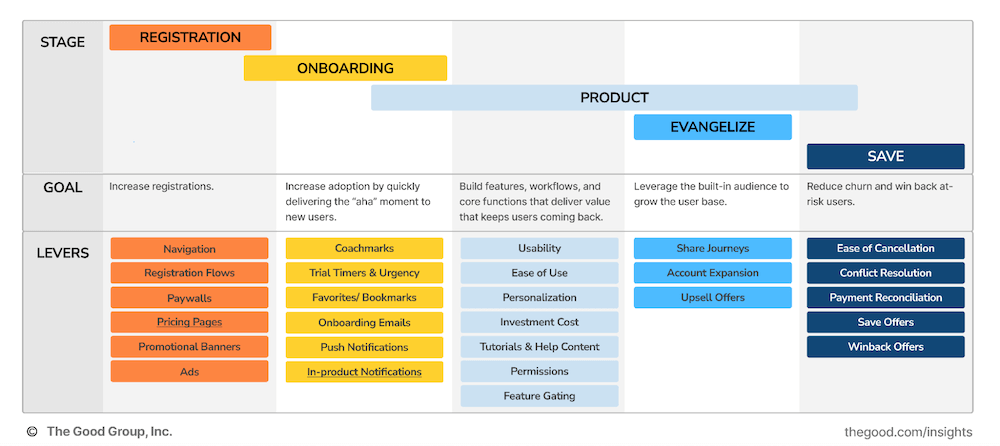
Accelerating Time-to-Value: How SaaS Products Get Users to ‘Aha!’ Moments Faster
Learn how strategies like optimizing onboarding, personalizing the user experience, and implementing quick wins can improve SaaS product time-to-value and reduce churn.
Over half of all downloaded apps are uninstalled in the first 30 days, and some studies show almost 80% of free trial users never convert to paying customers.
What is going wrong? The most common assumption is a poor product experience, but something else could be the culprit: SaaS products take too long to deliver value.
If users don’t quickly experience how software makes their life better, they will delete the app or simply abandon their account.
If you find your users in this position, accelerating time-to-value should be at the top of your priority list. Reducing the time it takes a customer to find value in your product can increase customer satisfaction by 10% to 30%, which will have a direct impact on retention.
In this article, we’ll share how strategies like optimizing onboarding, personalizing the user experience, and implementing quick wins can help you improve time-to-value and reduce churn.
What is time-to-value (TTV)?
Time-to-value is the duration of time it takes a user to experience the value of your SaaS product. It measures the time lapsed from when a user starts engaging with your tool to when they have an ‘Aha!’ moment about the positive impact on their life.
Types of time-to-value:
- Time-to-basic value: A metric measuring the time it takes a customer to see any value from your product.
- Time-to-exceed value: A metric measuring the time it takes to exceed a user’s expectations about your product’s value.
- Long time-to-value SaaS: A product or service that takes a longer duration of time to realize value (sometimes weeks or months). Usually, for SaaS, this is true when it takes time to integrate systems or data. In this case, it’s important to demonstrate incremental value during the journey to full value.
- Short time-to-value SaaS: A product or service that meets an immediate need, such as a transactional software product with a one-time use.
- Immediate time-to-value SaaS: A product or service with an instant reward for customer actions, such as a picture resizing or link shortening software.
How to calculate time-to-value
The simple time-to-value formula is:
TTV = Time that value is realized – Time user starts engaging with your product
But while the concept of time to value is pretty straightforward, how you calculate it will vary.
Your unique product, user, and definition of value will help guide the inputs of your TTV formula. Here is a quick overview of how to calculate time to value for your business:
- Define value: What does finding value mean in the context of your product? Usually, it is how long it takes a user to complete a specific task that showcases the core function of your product.
- Define the start time: When do you start measuring the users’ path to value? What is the starting point of their journey? Usually, it’s during the registration or onboarding process.
- Define the end time: What is the moment a customer realizes value for your product? You’ll likely need to conduct research to pinpoint the ‘Aha!’ moment (more on that later). Typically, it takes the form of achieving a specific outcome, uncovering a benefit, or reaching a milestone.
- Calculate the duration: Measure the time between the start and end points. This is your time to value.

Some examples of how actual SaaS companies measure time-to-value include: how long it takes for a user to upgrade from free to paid, how quickly users start a new project after onboarding, or how long it takes to get the first ROI from the tool.
Why is time-to-value important?
Time-to-value directly impacts product success. It is an early indicator of retention and churn, and can help uncover areas for optimization.
The metric is especially important for companies with freemium or free trial pricing models. When your monetization happens during the product experience, you need to show your value explicitly and efficiently. Time-to-value is a way to measure if you are doing so successfully.
Enjoying this article?
Subscribe to our newsletter, Good Question, to get insights like this sent straight to your inbox.
How to improve time-to-value
Demonstrating your value early on takes your SaaS product from ‘nice-to-have’ to ‘can’t live without.’ Here are a few strategies to help you do it.
Identify your product’s ‘Aha!’ moments
To get to the ‘Aha!’ moments faster, you first need to understand what those eye-opening experiences are. What turns casual users into lifelong customers? What is the first product experience that clearly shows your product’s potential impact on a user’s life?
To identify those ‘Aha!’ moments (or the end time in your formula), there is nothing more effective than talking to and studying the users themselves.
With user research methods like session recordings, usability tests, interviews, and surveys, you can uncover the intrinsic motivations of your users and take stock of their goals. What you find in your UX research process will help identify which product experiences will be most valuable to them and help prioritize which to show off early.
For example, if a new user of your project management tool wants to gain transparency across their team, the product should show them how to do that before it does anything else.
It will be tempting to bombard new users with all the amazing features of your tool, but to provide the quickest route to value for each user, you have to understand their objectives and why they are exploring your tool in the first place.
Personalize the user experience
The meaning of value will vary across your user base and their unique needs. For example, a 10-strong team signing up for an analytics tool may find different early value than a one-person team looking to monitor their small business. Or someone who has less tech know-how might need more hand-holding, while someone already comfortable with complex systems might want to see more intricate aspects upfront.
That’s why it’s important to personalize the user experience to accelerate time-to-value.
It doesn’t have to be 1:1 personalization, though. There’s a good chance there will be groups of users who have similar goals. Gain insight into your users, identify patterns, and create experiences for those groups. Start with a few segments and then continue to add on personalization if you see it’s working.
Optimize the registration and onboarding experiences
One significant lever for accelerating time to value is improving early product experiences.
The ROPES framework, designed to help product-first leaders think about, optimize, and improve the end-to-end customer experience, shows how the R (registration) and O (onboarding) experiences might help or hinder TTV.
While the other elements of the customer journey can play a part, the biggest drivers for reducing TTV lie in those first stages of the product experience.

While there is no exact blueprint for optimization, there are some commonalities you can bear in mind for improving registration and onboarding:
- Take it slowly: The last thing you want to do is dump everything onto new signups. Avoid overwhelming by trickling out information and allowing users to go at their own pace.
- Put the user first: The best experiences focus on the needs of each individual user and what they need to know to get started.
- Leverage novel UI mechanisms: Make use of novel mechanisms like tooltips or a modal window to gently guide users through the registration onboarding process.
- Give clear step-by-step instructions: Clearly guide users through your registration and onboarding step-by-step. Make it straightforward to complete, and be sure to highlight your product’s use cases during the process.
- Follow good form design principles: Show clear progress, give feedback as they go, and group common information to make it easily digestible.
- Collect feedback: Track and measure how successful your process is by asking new signups for their feedback.
Your product experience should be fluid. The needs of your user base will change over time, and you must listen to user feedback if you want to continue to improve the experience and showcase your value more efficiently.
Implement quick wins for users
Quick wins are a great tactic for improving time to value. Get your new users to complete small actions quickly so they start to feel comfortable using your tool ASAP.
Quick wins create initial momentum for users, playing into the psychology that when you feel accomplished or successful, you’re inclined to continue succeeding. This is similar to basketball players who gain confidence as they continue scoring points (hot streak) or that feeling when you have a task list of chores to do and you begin crossing them off one by one. Momentum is something that is built and will carry users forward.
As you build their confidence with your tool, you can use those quick wins to show the valuable features or functionality that is relevant to them.
Measure and iterate
No product experience gets it exactly right the first time, and there are always ways to continue improving your time to value.
Just like your users are learning how to use your product, you’re also learning how they use it. The more clarity you get on challenges, use cases, and goals, the easier it’ll be to create a valuable experience early on.
Continuously test different journeys, tweak steps based on user feedback, and don’t forget to track everything you do to see what works and what doesn’t.
Signs your time-to-value is too slow
It’s true that there is always room for TTV improvement, but how do you know you have a big problem?
Here are some red flags to look out for:
- High churn or low retention rates: Customers are leaving your service early in their subscription cycle, usually the first 30, 60, or 90 days.
- Low upgrade rate: Users don’t upgrade on their own, and/or sales teams get resistance to any account expansion or new offering pitches. This means customers are either seeing too much or too little value on their current account level.
- Low engagement with core features: Infrequent logins or low engagement with your core product functions/features means users don’t see the value of your product.
- Poor NPS: The feedback you receive is largely neutral or even negative.
- High customer acquisition costs: When users abandon, and you have to replace lost users, your cost of acquiring new customers will increase.
- Customer success or sales complaints: Your customer success team spends almost all their time resolving issues, or the sales team can’t clearly show the ROI of your product.
If you see one or many of these red flags, it’s time to start a new UX research cycle and dig into where there is room to optimize and show your value earlier on.
To get an expert’s POV on the situation, reach out to The Good. We can help uncover where and why your users are dropping off, and help you fix it.

About the Author
Caroline Appert
Caroline Appert is the Director of Marketing at The Good. She has proven success in crafting marketing strategies and executing revenue-boosting campaigns for companies in a diverse set of industries.